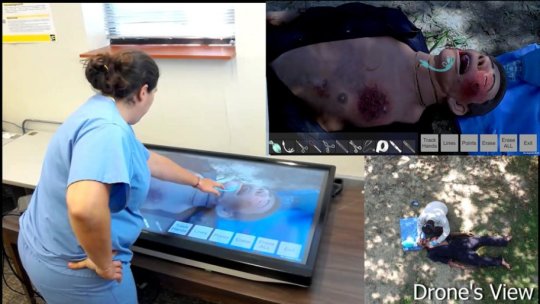[ad_1]
Purdue University researchers have developed a unique approach that allows experienced surgeons and physicians around the world to help less-experienced doctors in war zones, natural disasters and in rural areas perform complicated procedures.
“The most critical challenge is to provide surgical expertise into the battlefield when it is most required,” said Juan Wachs, Purdue’s James A. and Sharon M. Tompkins Rising Star Associate Professor of Industrial Engineering, who led the project team. “Even without having highly experienced medical leaders physically co-located in the field, with this technology we can help minimize the number of casualties while maximizing treatment at the point of injury.”
The team presented the work at the 2018 Military Health System Research Symposium, held Aug. 20-23 in Kissimmee, Florida. Watch a video of how the system works here: https://www.youtube.com/watch?v=zla1qTV9uf8
The Purdue technique involves using augmented reality tools to connect health care professionals in remote areas with more experienced surgeons and physicians around the world. The AR headset worn by the mentee in the field is designed to replace current telestrator technology, which uses a separate video screen and freehand sketches to provide feedback.
“There is an unmet need for technology that connects health care mentees in rural areas with experienced mentors,” said Edgar Rojas Muñoz, a doctoral student in industrial engineering, who worked on the project. “The current use of a telestrator in these situations is inefficient because they require the mentee to focus on a separate screen, fail to show upcoming steps and give the mentor an incomplete picture of the ongoing procedure.”
The Purdue system features a transparent headset screen display that allows the mentee to see the patient in front of them, along with real-time on-screen feedback from the mentor. That mentor is at a separate location using a video monitor to see the AR feed and provide instant feedback to the field surgeon.
Purdue’s system uses computer vision algorithms to track and align the virtual notes and marks from the mentor with the surgical region in front of the mentee.
“Our technology allows trainees to remain focused on the surgical procedure and reduces the potential for errors during surgery,” Muñoz said.
The U.S. Department of Defense supported the research as it looks to connect its medical professionals out in the field with specialists back at the bases who can provide critical guidance during procedures.
The Purdue technology has gone through a round of clinical evaluation and will soon go through another one. In the next few months, the technology will be tested at a Navy base in Virginia, where mentees and mentors will experiment with a simulated battlefield.
Researchers at Purdue also are working to increase the stabilization ability of the view for the mentees.
Other researchers on the project include Voicu Popescu, an associate professor of computer science at Purdue; Brian Mullis and Ben Zarzaur from the Indiana University School of Medicine; and nurse researchers Kathryn Anderson and Sherri Marley from Eskenazi Health Services in Indianapolis.
The technology aligns with Purdue’s “giant leaps” celebrating the university’s global advancements made in health, space, artificial intelligence and sustainability highlights as part of Purdue’s 150th anniversary. Those are the four themes of the yearlong celebration’s Ideas Festival, designed to showcase Purdue as an intellectual center solving real-world issues.
The team is working with the Purdue Office of Technology Commercialization on patents for the technology. The research team also is looking for partners.
Story Source:
Materials provided by Purdue University. Original written by Chris Adam. Note: Content may be edited for style and length.
[ad_2]















